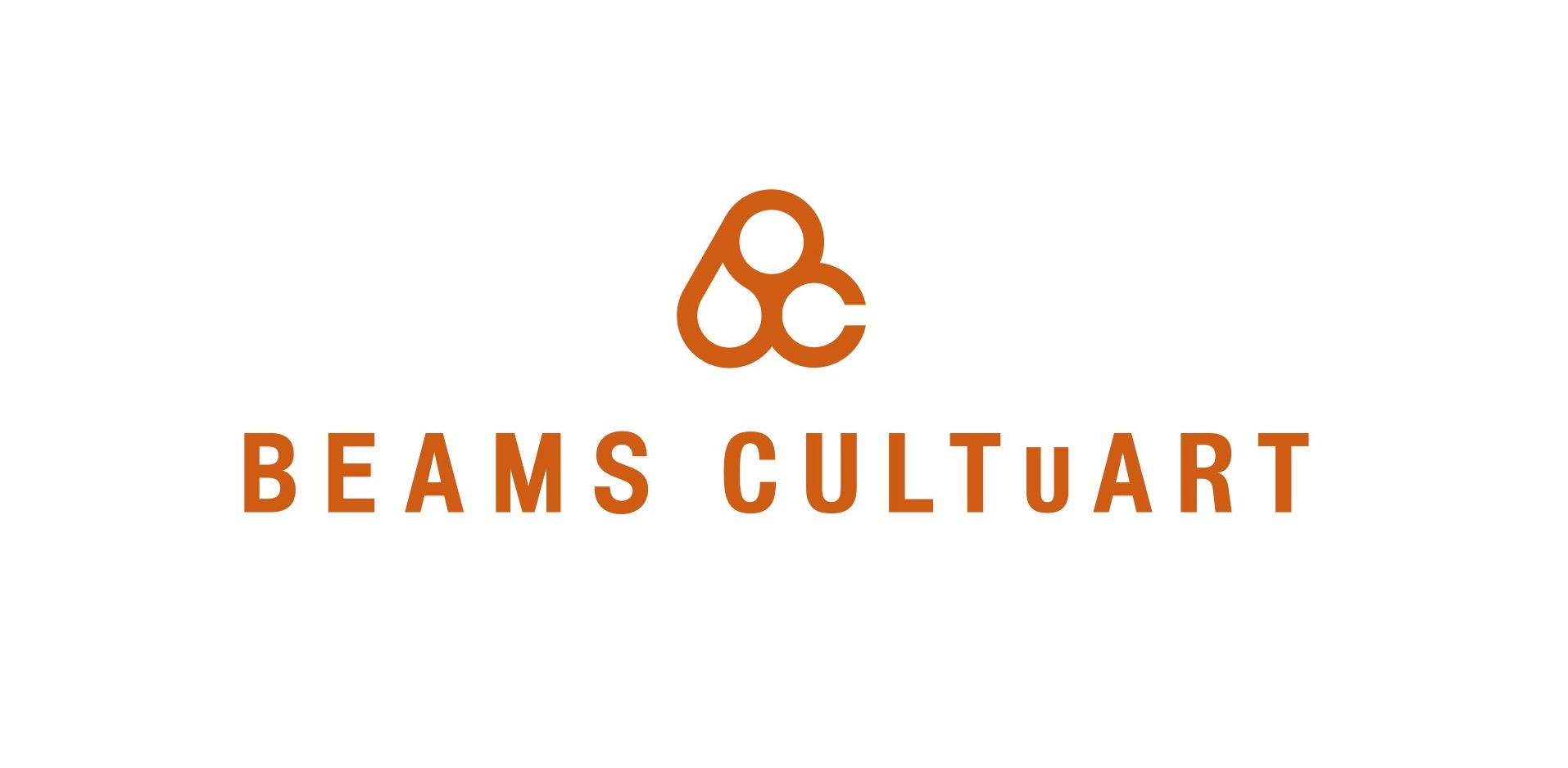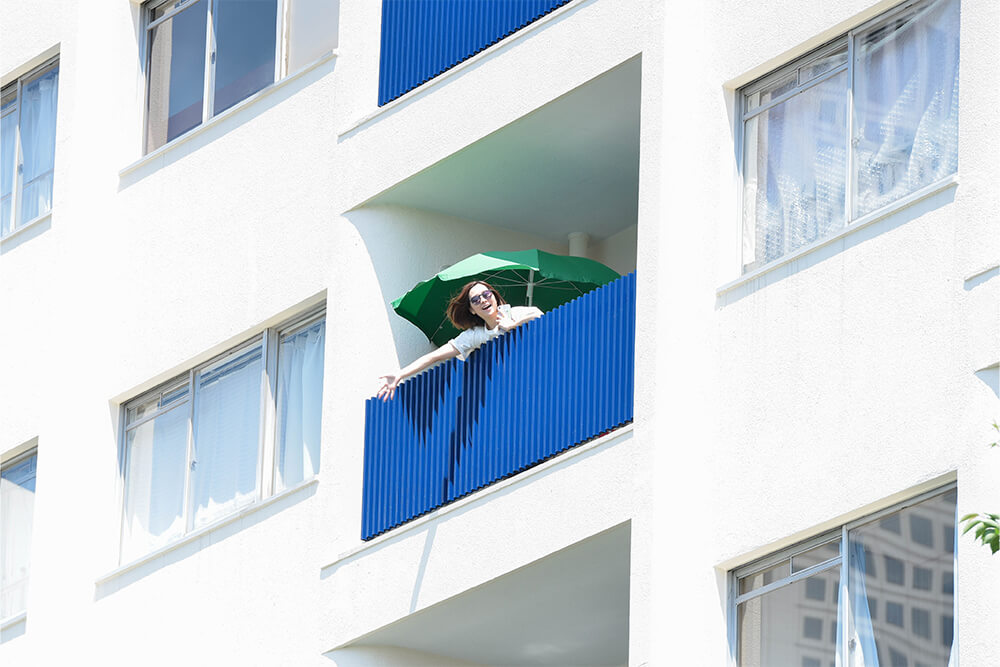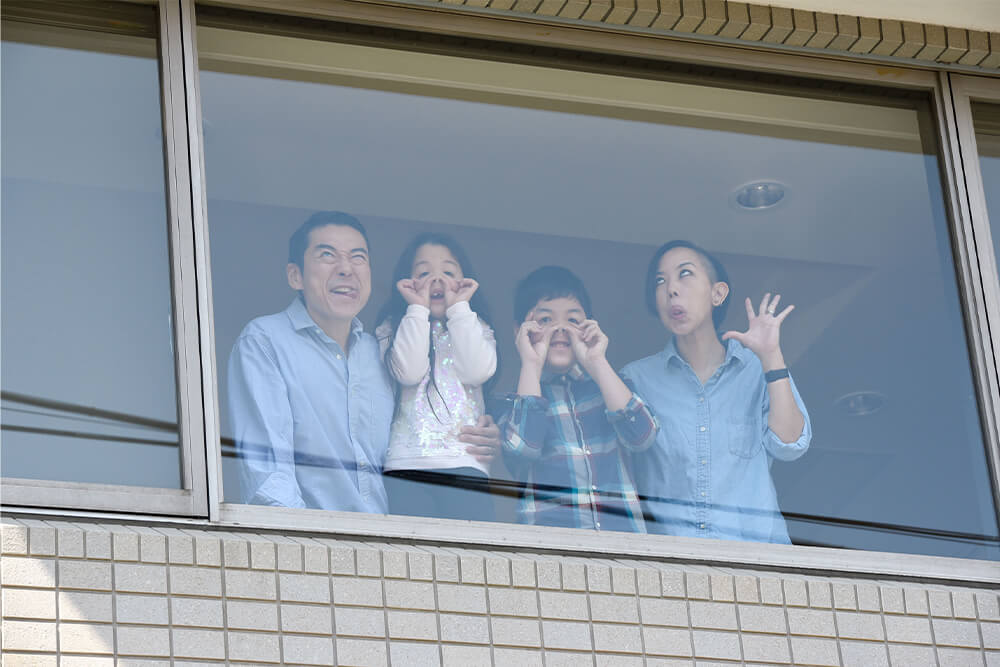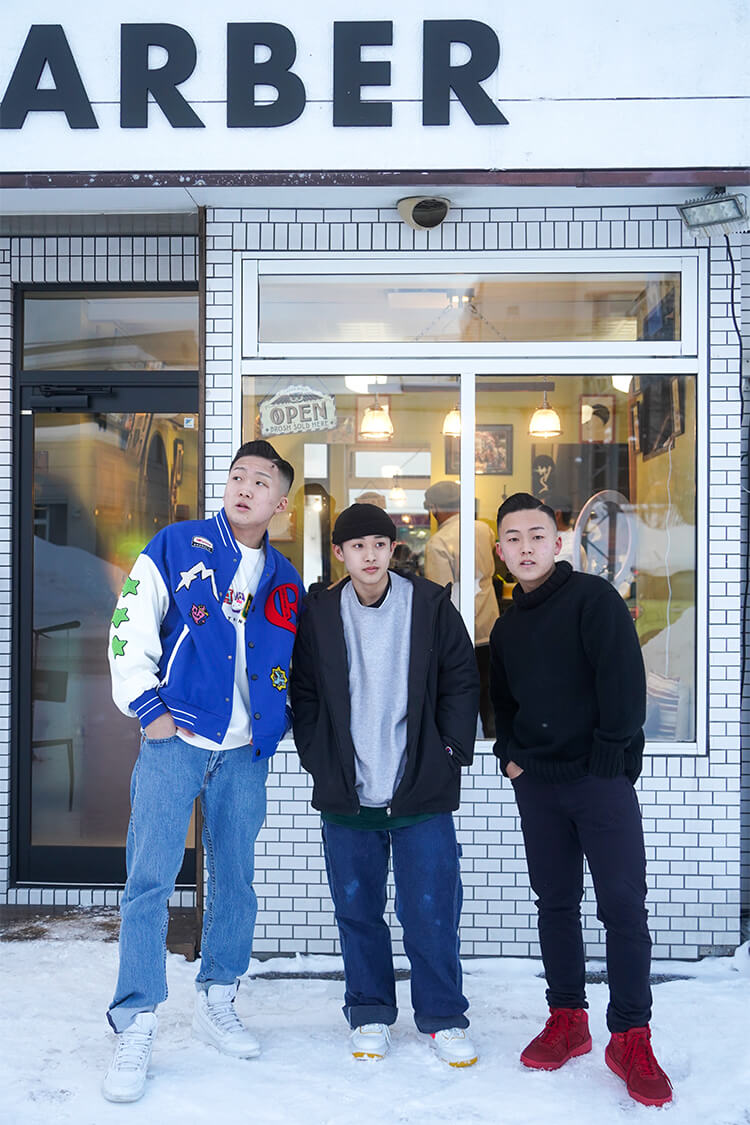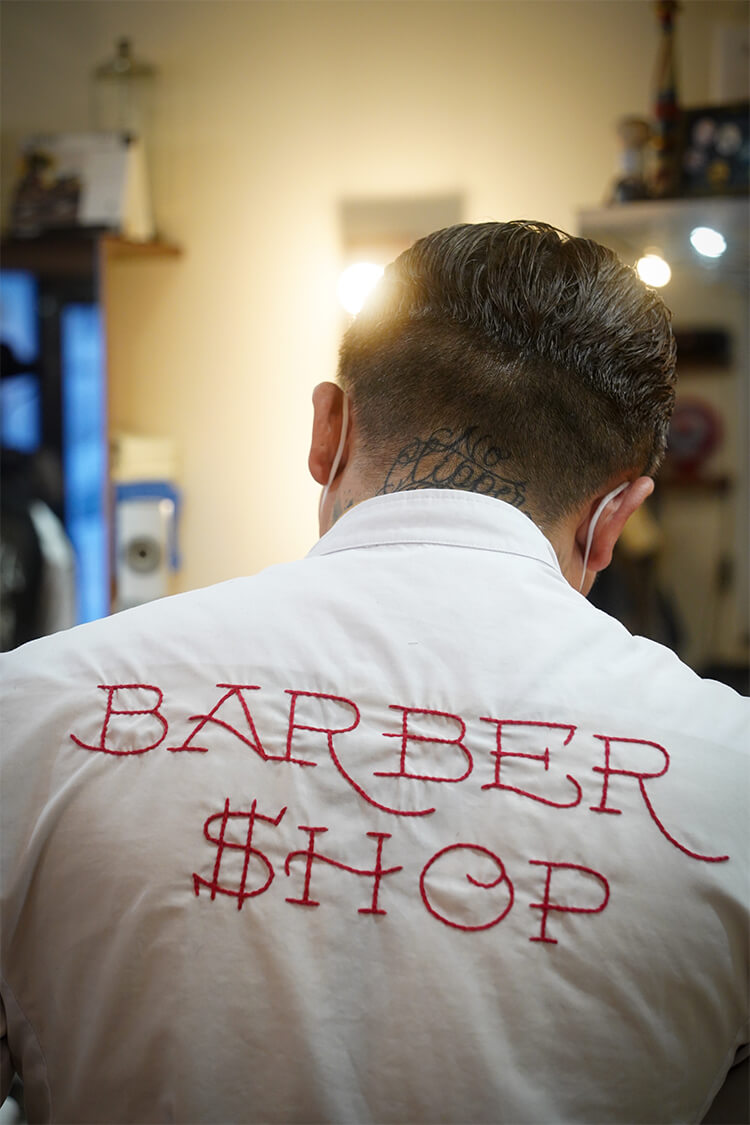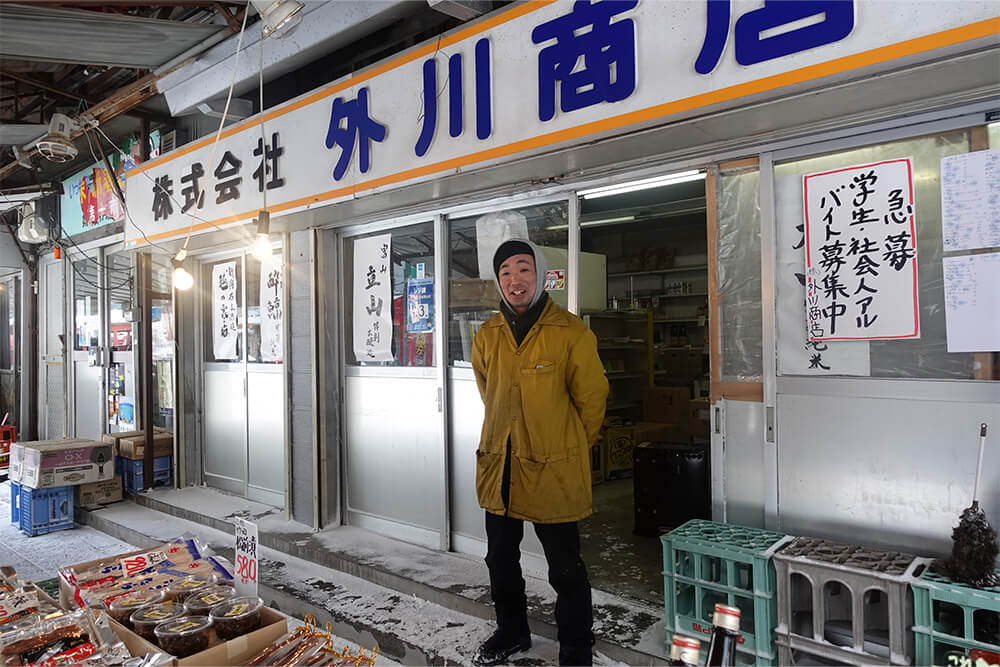

写真家・山本佳代子が旭川で見つけた“満塁”の日々。
Photographer Kayoko Yamamoto found her "Full Base" days in Asahikawa.
2021年1月から3月にかけて、写真家・山本佳代子さんは北海道の旭川にいました。50日以上という月日をそこで過ごす中で、自身が見て感じたことを写真に残すためです。そうしてできた作品群が『満塁』。「B GALLERY」では、旭川で撮影された写真100点以上を3月21日(月)まで展示しています。今回は、そんな『満塁』の制作の裏話を聞いてきました。ちなみに、野球はまったく関係ありません。
Between January and March 2021, photographer Kayoko Yamamoto spent more than 50 days in Asahikawa, Hokkaido, to capture what she saw and felt during her stay there. The resulting work is "Full Base". The "B GALLERY" is exhibiting more than 100 photographs taken in Asahikawa until March 21 (Mon). In this interview, we asked her about the story behind the production of "Full Base". By the way, it has nothing to do with baseball at all.
PROFILE

山本佳代子
(写真家)
埼玉県出身、東京都在住。レコード会社勤務を経て、2011年よりフォトグラファーとして活動をスタート。主に著名人やミュージシャンのポートレートやライブ写真を手掛ける。2020年、コロナ禍のなか、バルコニー越しで友人たちを撮影した「#balconyshootingtour」が話題となる。
Official Site
『満塁』ができるまで。
ー 山本さんの撮る写真は、今回の『満塁』や過去の作品を見ても、人を被写体にされていることが多いですよね。
山本:撮影していて、面白いと思えるのが人なんです。今回の『満塁』は笑顔の写真が多いですけど、笑顔が撮りたいわけじゃなくて。被写体の一番らしい表情を撮りたい。それが寛いでいるときかもしれないし、ちょっと抜けている表情かもしれない。そういう瞬間を撮れたときは、本当に気持ちいいんですよね。
ー 山本さんの写真の中の人たちは、みんなリラックスした表情をされていると思うんです。なにか秘訣ってあるんでしょうか?
山本:とにかく、自分がゆるゆるになるっていうか。アホになります(笑)。あとは、女性っていうのもあるかもしれません。男性よりは威圧感はないですからね。
ー 昨年、山本さんが撮影された『バルコニー・シューティング・ツアー』も、みなさんいい表情でした。そして企画力もすごいなと思ったんです。
山本:コロナ禍って、世界中のみんなにとって初めての体験じゃないですか。家から出ちゃいけないっていう。私もコンビニに行くのすら怖かったし、人にも全然会ってなかったんです。だけどあるとき、写真を無性に撮りたくなって。でも、人を撮るにしても外に出ちゃいけないし、近づけない。となったときに、私が出向いて、遠くから撮ればいいんじゃんって。それで、「私が遠くから撮りに行くから、バルコニーで待っててくれる人いる?」ってインスタで聞いてみたら、いろんな友達たちから「撮りに来てよ」と言ってもらって、あの作品ができました。
ー そうして、『バルコニー・シューティング・ツアー』から派生して、BEAMSでは動画企画「会いたい。」を一緒に制作させていただきました。
山本: SNSに写真をアップしていたら、知り合いが繋いでくれて。そのまま、あれよあれよという間に決まりましたね。写真をアップした1週間後ぐらいには、BEAMSで動画がアップされるくらいのスピード感で。それがBEAMSさんとのはじめての取り組みでしたね。
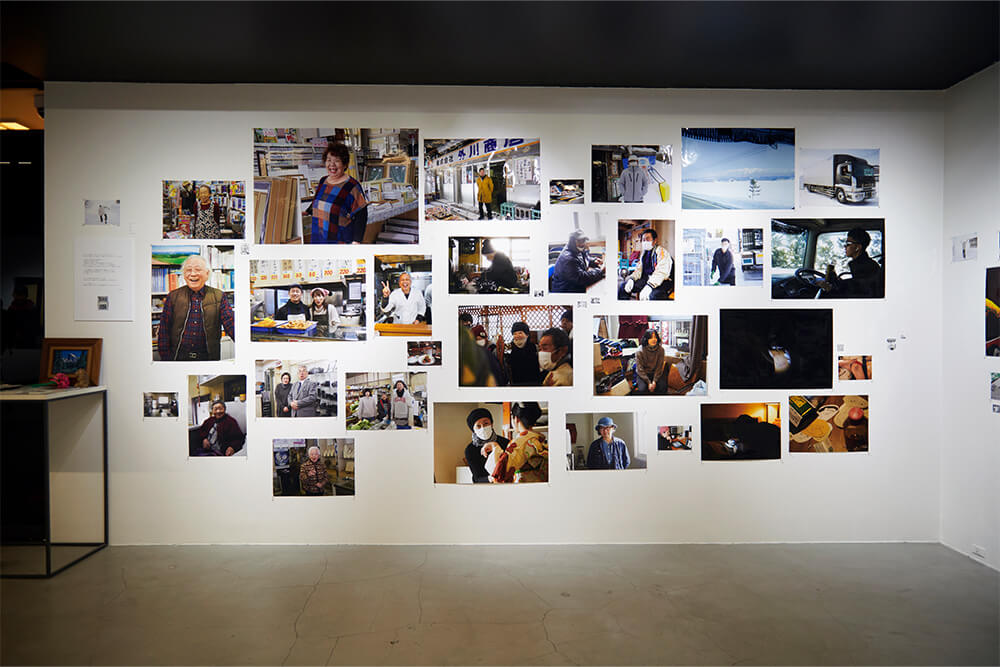
ー ここからは、『満塁』の制作秘話を伺っていきたいのですが、まず、ことのはじまりを教えていただけますか?
山本:旭川のアーティスト・イン・レジデンス(クリエイターを一定期間その土地に招聘し、作品の制作をサポートする事業)に選んでいただいたんです。ビル一棟がアーティスト・イン・レジデンスの持ち物で、1階がギャラリー、 2階と3階が住居という場所で。
ー 山本さんが旭川にゆかりがある、とかではないんですよね?
山本:実は旭川に友人がいまして。私が以前勤めていたレコード会社の元同僚なんですけど。彼女は旭川出身で、会社を辞めてUターンしていたんです。それで、運営を手伝っていた彼女から「佳代子も呼びたい」と言ってもらって。
ー 1月13日から3月7日までの54日間、滞在されていたと。ちょうど一番寒い時期ですよね。
山本:マイナス20度の日もありましたからね。ただ、寒いは寒いですけど、風はないし、シーンとしていて、キンキンに冷えたあの感じは好きでした。もう一回戻りたいと思うくらい。
ー まったく知らない土地にいきなり放り出されて、戸惑いはなかったですか?
山本:東京はコロナ禍でピリピリしていたときだったので、旭川の人たちが東京から来る私を怖いと思わないかと心配してたんですけど。着いた初日に、ウェルカムパーティーを開いてくれたんです。暖かく歓迎してもらって、不安はすぐになくなりましたね。
ー 杞憂に終わったわけですね。『満塁』のなかで撮影されている人たちとは、どういう風に出会っていったんでしょうか?
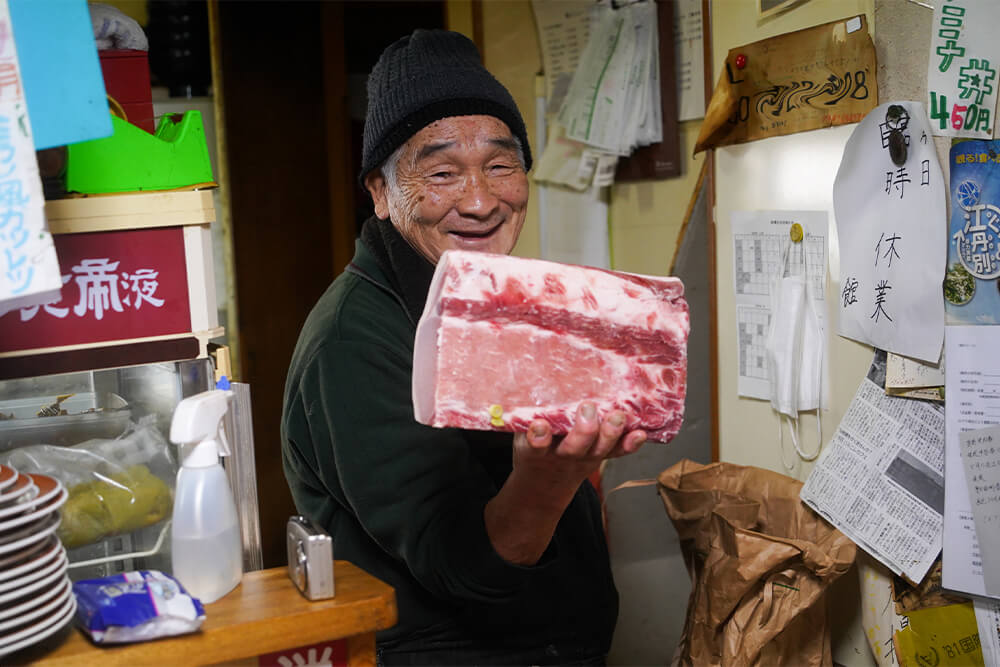
山本さんが旭川へ到着して最初に撮影した、「食事処 館」のおじさん。実は撮影日が、お店の営業の最終日だったそう。
山本:誰々に会わせたいとか、どこどこに連れて行きたいとか、旭川の人たちみんなが提案してきてくれて。いざ撮影をはじめたら、超忙しかったんです。1日3箇所を回ったりなんかして、それが毎日。写真だと楽しそうですけど、日々の生活は予想以上にハードでした(笑)。
ー ほかにも、人と出会う方法はあったんでしょうか?

旭川で山本さんが通っていた溜まり場「ボーフラ」。
山本:旭川市内にたまり場みたいな場所があったんです。奥がライブハウスで、手前がバーになっている「ボーフラ」っていうお店で。週2日だけ、大皿でお料理が振舞われる日があって、音楽好きとかカルチャー好きが集まるんです。そこでの出会いも多かったですね。
ー 人との出会い方も、東京とはまた違うんですね。
山本:東京だと音楽もファッションも、すべてジャンルで分断されているじゃないですか。ジャンルによって集まる場所が違ったり。でも、「ボーフラ」にはパンク好きも、ヒップホップ好きも、ハードコアの人もいてみたいに、ジャンルの隔てがなく人が集まっているんですよ。それも、なんだか新鮮でした。
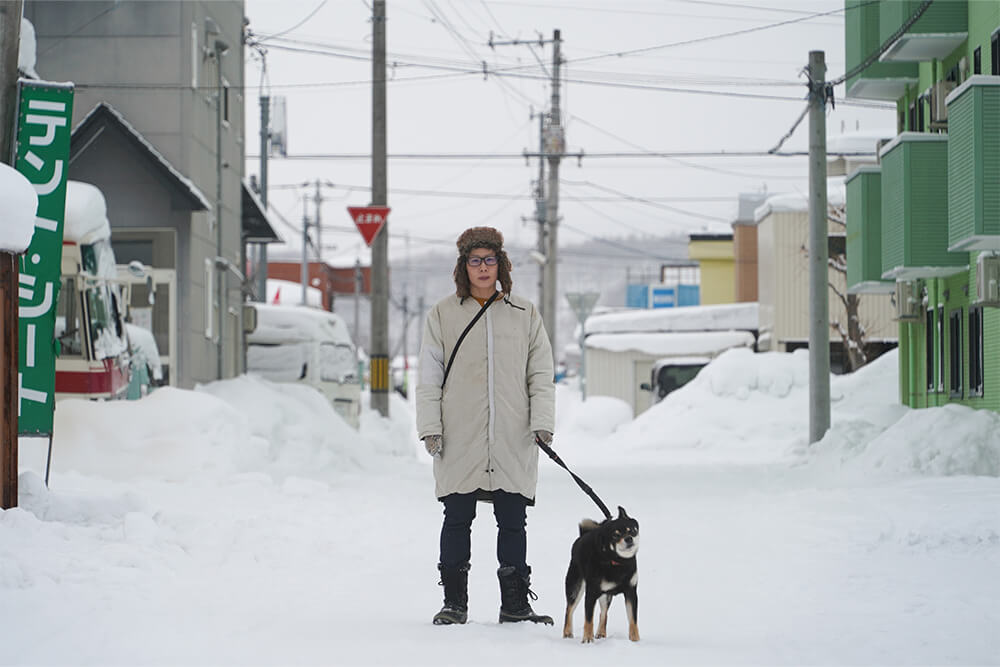
山本さんのレコード会社時代の同僚。毎日送り迎えをしてくれていたという。

ドラマ『孤独のグルメ』で紹介されたことでも有名な「自由軒」の大将。「ここのカニクリームコロッケが本当においしくて」と山本さん。
ー 小さな街だと、そうした分断はないかもしれないですね。もっと大きなくくりで集まるというか。
山本:そうなんです。あと、滞在してしばらくすると、「何時に、佳代さんが来るよ」みたいな話もされていたみたいなんです。その頃はたぶん、街で一番有名人だったんじゃないかな(笑)。そうして、みんなが自主的に会いに来てくれてたところもあります。
山本佳代子と人と写真。

ー 山本さんはそもそも、なぜ写真を始められたんでしょうか?
山本:中学生ぐらいから写真が好きで、修学旅行とかで撮影してたんです。それをクラスの子達みんなが欲しいって言ってくれて。その喜びを体験してから、ずっとカメラを持ち歩くようになりましたね。
ー それが、フォトグラファーの原体験になったんですね。
山本:そうです。大学に入ってからは、写真部で現像なんかも勉強したり、より一層のめり込むようになっていって。でも、卒業後はカメラマンになるなんて考えも及ばず、レコード会社に就職しました。
ー レコード会社でも撮影をされていたんですか?
山本:いや、全然です。あるとき宣伝部に異動になって、取材を取り仕切る側になり、カメラマンと接する機会が増えていったんです。そのときに「本当は私、こっちをやりたかったんだよな」って気付いて。だけど、いまさらアシスタントについたりは難しいななんて考えていたときに、東日本大震災が起こったんです。そこで、自分が後悔しないように生きなきゃと思って、会社を辞めて独立しました。
ー いきなり仕事は来るものでしょうか?
山本:レコード会社にいたこともあって、コネクションだけはあったんですよね。皆さんのやさしさでちょこちょことお仕事をいただけるようになって。だからいまも、アーティストやライブ写真を撮ることが多いんです。
ー そうしたクライアントワークとは違って、今回の『満塁』では一般の方が被写体になっていますよね。出会ったすべての方を撮影するってわけにはいかないと思うんですけど、撮る撮らないの基準ってあったりするんでしょうか?
山本:私も興味があるし、向こうも私に興味を持ってくれているっていうのが分かった時かな。お互いに想いが通じ合ってる人を撮影していた気がします。
ー 『満塁』制作時で、一番思い出深いエピソードはありますか?
山本:一番というのは難しいですけど、ハマっていたのが男の子3人組です。『3人のたばこ』ってユニットで。
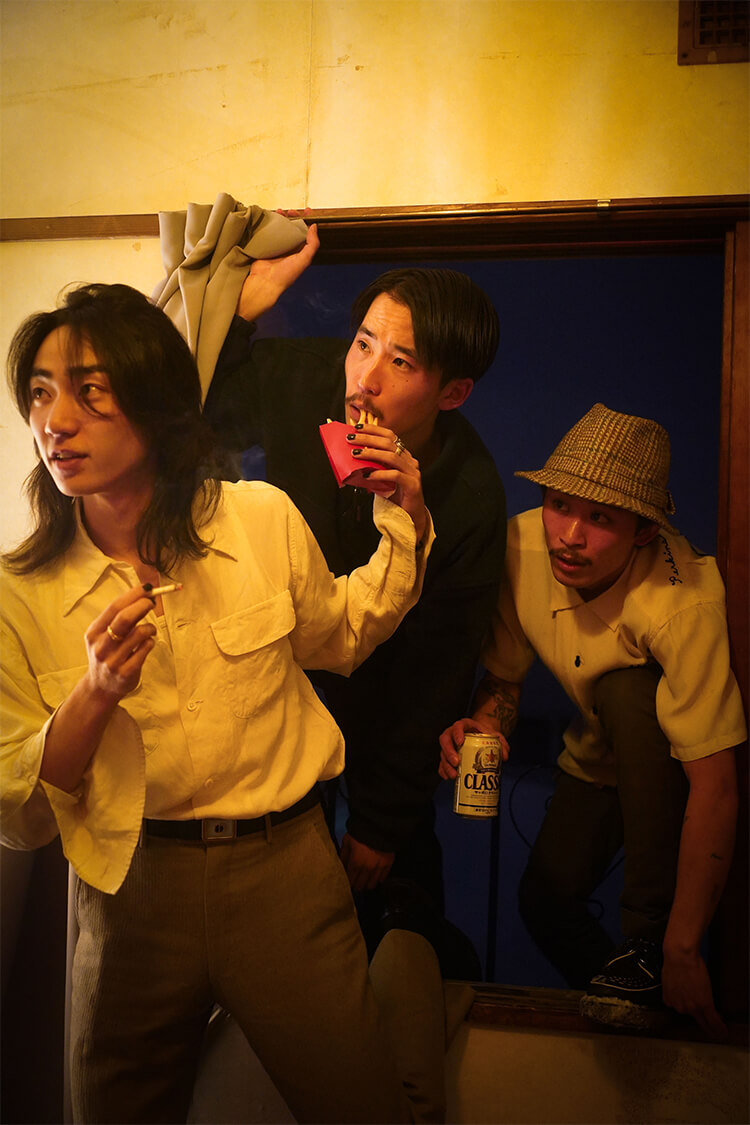
『3人のたばこ』の3人。
山本:写真右からタトゥーを彫っているFLATくん、真ん中が茨城から木工を勉強するために来ていた舘くん、いちばん左が古着屋で働いていたりイラストを描くすぐるくんです。みんな23、4歳くらいだったかな。彼らは、今後も撮り続けたいなと思っています。
ー どこに魅力を感じたんですか?
山本:私は埼玉生まれで、東京にずっと憧れがあったし、東京が一番なんだっていう感覚でずっと生きてきたんです。だけど、彼らは別にそんな感じでもなく、自分にとって心地いい場所を旭川のなかでつくっていて。東京も旭川もフラットに見ていて、どちらにも執着していないんですよね。そういう自分の芯があって、メディアとかに流されない姿勢に惹かれましたね。
ー 写真からでも、3人がそれぞれ自分のスタイルを持っているのが分かります。
山本:東京にいなくても、これだけお洒落で、スタイルがあるっていうのが素敵ですよね。だけど早速、タトゥーを彫っている子が、東京に来るとか言い出していますけど(笑)。
ー (笑)。その揺らぎもまた、いいですね。
山本:彼には、今回の展示に合わせて、 Tシャツのイラストを描いてもらったんです。会場で販売しているので、ぜひみなさんに見ていただきたいです。
ー そもそも、なぜタイトルが『満塁』なんでしょうか? 野球は関係ないですよね?
山本:深い意味があるわけじゃないんです。とにかくもう、旭川の日々が濃厚過ぎて幸せで。心も体力も脳ミソもパンパンで「もう無理です」って感じだったので、『満塁』になりました。
ー 山本さんが命名されたんでしょうか?
山本:旭川での展示のタイトルを決めるときに、私が悩んでいることをみんな知っていて、じゃあみんなで考えよう、となったんです。その中で「私のいまの状態を野球に例えたら」という話になり、「それはもう満塁だね!」、みたいな(笑)。
ー 旭川での滞在は山本さん自身にどういう影響を与えましたか?
山本:たぶん私、東京で暮らしすぎていて、自分を守るための分厚い鎧を着ていたんです。自分を愛してあげられてなかったなって。今までは年齢を気にしたり、自分の名前も表に出さないようにしていたんですけど、それがほぐれてきた感じがします。
どうあがいても、自分は自分だから、受け入れなきゃなと思うようになりましたね。ただ、今日もなんですけど、写真を撮られるのはいまだにちょっと、苦手です(笑)。
INFORMATION

山本佳代子 “満塁”
会期:2022年2月18日(金)〜2022年3月21日(月)
場所:B GALLERY
PROFILE

Kayoko Yamamoto
(Photographer)
Born in Saitama Prefecture and currently residing in Tokyo. After working for a record company, she started her career as a photographer in 2011. She mainly takes portraits of celebrities and musicians and concert photos.
In 2020, amidst the pandemic, a series of photographs she took of her friends over their balconies named “#balconyshootingtour”, became the talk of the town.
Official Site
The process of making “Full Base”
ー In your photographs, both in “Full Base” and in your past works, you often use people as your subjects, don’t you?
Yamamoto: People are what I find interesting when I am shooting. There are a lot of smiling faces in “Full Base”, but it is not that I want to take smiling pictures. I just want to capture the best expressions of my subjects. It might be when they are relaxed, or when they look a little out of sorts. When I am able to capture such moments, I feel really good.
ー People in your photos all seem to have relaxed expressions. Is there a secret to this?
Yamamoto: The point is I take the initiative to relax and be silly (laughs). Also, maybe it is because I am a woman. Generally speaking, women are less intimidating than men.
ー Last year, when you shot the “Balcony Shooting Tour,” everyone had great expressions on their faces. I was also impressed by your strategy.
Yamamoto: Covid-19 pandemic was a new experience for everyone in the world. At first, we were encouraged not to leave our homes. I was afraid to even go to a convenience store, and I didn’t see anyone at all. One day, however, I felt an irresistible urge to take pictures. But even if I wanted to take pictures of people, I was hesitant to go outside and get close to them. So I thought, Why not just go out and take pictures from afar? So I asked on Instagram, “I’m going out to take pictures from afar, so who wants to pose for me on the balcony?”, and various friends told me to come take pictures of them, and that work was completed.
ー Derived from the “Balcony Shooting Tour,” you let us co-produce a video project called “I want to meet you”.
Yamamoto: I was uploading photos on social networking sites and an acquaintance connected me to you. It was just a matter of time before we decided on the project. About a week after I uploaded the photos, the video was uploaded on the BEAMS site. That was the first time I worked with you.

ー Let me ask you about the story behind the production of “Full Base”. First of all, can you tell us how it all started?
Yamamoto: I was selected as an artist-in-residence in Asahikawa (a program that invites creators to a certain location for a certain period of time and supports them in creating artwork). The entire building belongs to the Artist-In-Residence (AIR), with a gallery on the first floor and residences on the second and third floors.
ー You don’t have any connection to Asahikawa, do you?
Yamamoto: Actually, I have a friend in Asahikawa. She is a former colleague of mine at the record company where I used to work. She is from Asahikawa and had quit her job and returned to her hometown. She was helping the administration of the AIR and recommended them to invite me as well.
ー You stayed there for 54 days from January 13 to March 7. That was the coldest time of the year, wasn’t it?
Yamamoto: There were days when it was minus 20 degrees Celsius. But although it was cold, there was no wind, and I liked the perfect silence and ice-cold feeling. I wouldn’t mind going back there again.
ー Did you feel at a loss when you were suddenly thrown into a place you knew nothing about?
Yamamoto: Tokyo was tense because of the pandemic, so I was worried that people in Asahikawa would be scared of me coming from Tokyo. But on the day I arrived, they threw me a welcome party. They welcomed me warmly, and my fears were soon put to rest.
ー So there was nothing to worry about. How did you meet the people photographed in “Full Base”?

The first person Yamamoto photographed upon her arrival in Asahikawa was the man at “Shokujidokoro Yakata” (Restaurant Yakata). In fact, the day of the photo shoot was the last day of business for the restaurant.
Yamamoto: Everyone in Asahikawa made suggestions about who they wanted me to meet, where they wanted to take me to, and so on. When I started shooting, I became extremely busy, visiting three places a day, every day. It looks fun in the picture, but my daily life was much harder than I expected (laughs).
ー Were there any other ways to meet people?

Bo-fura, a hangout that Mr. Yamamoto frequented in Asahikawa.
Yamamoto: There was a place in Asahikawa that was like a hangout. In the back was a live music club and in the front was a bar called Bo-fura. Two days a week, platters of food were served for people to share, and music and culture lovers would gather. I met a lot of people there.
ー I guess you meet people in a different way than in Tokyo.
Yamamoto: In Tokyo, music and fashion are all divided by genre. There are different places to gather depending on the genre. But at Bo-fura, there are people who like punk, hip-hop, and hardcore. People come together regardless of genre, and that was somewhat refreshing.

Yamamoto’s former colleague from her days at the record company, who drove her around every day.

The owner of Jiyuken, famous for being featured in the drama “Kodoku no Gourmet”. “The crab cream croquettes here are really delicious,” says Yamamoto.
ー In a small town, there may not be such a division. It’s more like coming together as a larger group.
Yamamoto: Yes, that’s right. Also, after staying a while, it seems that people would know what time I’d be arriving nearby. I was probably the most famous person in town at that time (laughs). So in some ways, people came to see me voluntarily.
Kayoko Yamamoto and people and photography.

ー Why did you take up photography in the first place?
Yamamoto: I have loved photography since I was in junior high school, and I used to take pictures on occasions like school trips. All the kids in my class wanted to have them. After experiencing that joy, I started carrying a camera with me all the time.
ー So that was your original experience as a photographer?
Yamamoto: That’s right. After entering university, I joined the photography club and learned about developing film, and I became more and more involved. But I never thought of becoming a photographer after graduation, so I went to work for a record company.
ー Were you taking pictures at the record company as well?
Yamamoto: No, not at all. One day I was transferred to the advertising department and became the one in charge of interviews, which gave me more opportunities to interact with photographers. That’s when I realized that what I really wanted was to be on their side. I was thinking that it might be too late to start from someone’s assistant, but then the Great East Japan Earthquake happened. I decided that I had to live my life without regrets, so I quit the company and started my own business.
ー Did jobs come so easily?
Yamamoto: I had been at a record company, so I only had connections. Thanks to everyone’s kindness, I was able to get a few jobs here and there. That is why I still often take pictures of musicians and live performances.
ー Unlike that kind of client work, you used ordinary people as your subjects in “Full Base” this time, didn’t you? I don’t think it’s possible to photograph everyone you meet, but do you have a standard for whom you do or do not photograph?
Yamamoto: When I know that I am interested in them and they are interested in me. I feel like I was shooting people whose feelings were mutual.
ー Do you have any most memorable episodes from the production of “Full Base”?
Yamamoto: It’s hard to pick, but I was into three boys for sure. They were a unit called “Sannin-no-Tabako” (Three Cigarettes).

Three of “Sannin-no-Tabako”
Yamamoto: From the right in the photo, there is FLAT who is a tattoo artist, in the middle is Tachi who came from Ibaraki to study woodworking, and on the far left is Suguru who works at a vintage clothing store and draws illustrations. They were all about 23 or 4 years old. I would like to continue photographing them in the future.
ー What attracted you to them?
Yamamoto: I was born in Saitama, and I have always had a longing for Tokyo, and I have lived my whole life with the feeling that Tokyo is the best. But they are not like that. They have created a place in Asahikawa that is comfortable for them. They see both Tokyo and Asahikawa plainly and are not attached to either. I was attracted to them because they have a core of their own and are not influenced by the media.
ー We can tell from the photos that each of the three has his own style.
Yamamoto: It’s great that they are so stylish and have their own flair even if they are not in Tokyo. But the tattooist has begun to talk about coming to Tokyo (laughs).
ー (laughs) I like that flexibility, too.
Yamamoto: I asked him to illustrate a T-shirt for this exhibition. The T-shirts are sold at the venue, so I hope everyone will take a look.
ー Why is the title “Full Base” in the first place? Baseball has nothing to do with it, right?
Yamamoto: There is no deep meaning. I just felt the days in Asahikawa were so rich and happy. My heart, body, and brain were so fulfilled that I felt like I couldn’t take any more, so I decided to go with “Full Base”.
ー Did you name it yourself?
Yamamoto: When I was deciding on a title for the exhibition in Asahikawa, everyone knew I was struggling, and they helped me come up with an idea. The conversation turned to “If I were to compare my current state to baseball,” to which I replied, “That’s a state of all bases being loaded!” and everyone agreed.(laughs)
ー What kind of impact did your stay in Asahikawa have on you?
Yamamoto: I probably lived too long in Tokyo and wore thick armor to protect myself. I didn’t love myself enough. I used to worry about my age and keep my name out of the public eye, but I feel like I’ve loosened up.
I have come to think that no matter what I do, I am who I am, and I have to accept that. However, I still don’t like having my picture taken, even today (laughs).
INFORMATION

Kayoko Yamamoto “Full Base”
February 18 (Fri), 2022 – March 21 (Mon), 2022
Place: B GALLERY






